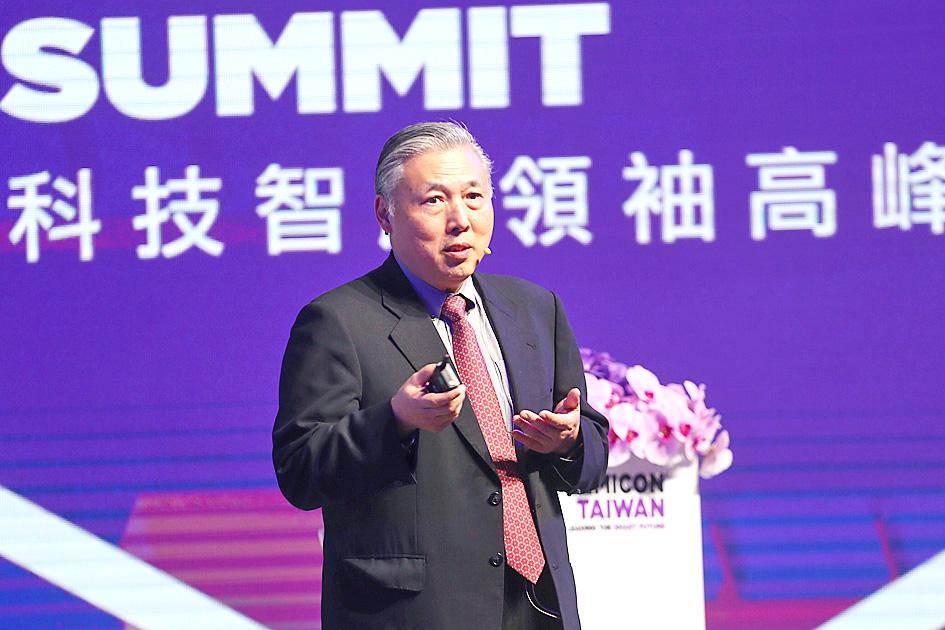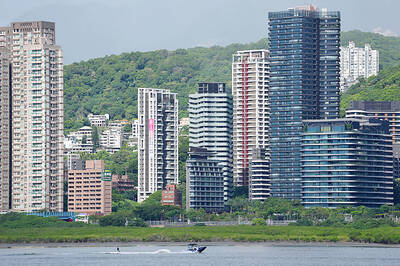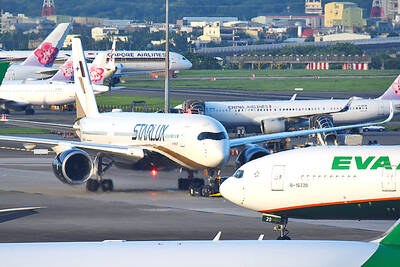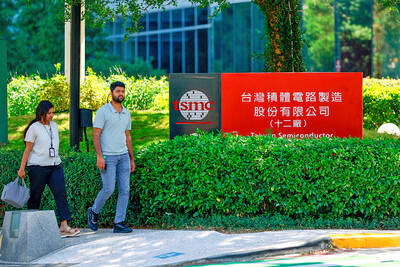ASE Technology Holding Co (日月光投控) yesterday said that capital expenditure this year might exceed the record US$2 billion spent last year, as demand for advanced packaging and testing services for chips used in high-performance computing, vehicles and 5G-related devices continues to be robust.
Long-term service agreements are in place through next year, ASE said, adding that discussions are being held with customers about further extensions, which could result in further capacity being added for loyal customers.
The world’s biggest chip assembler and tester said that the imbalance of semiconductor supply and demand is likely to extend beyond what it initially thought.

Photo: CNA
“Right now, we believe capacity and supply constraints will last beyond 2023,” ASE chief operating officer Tien Wu (吳田玉) told a virtual investors’ conference.
“We have seen broad-base growth in all sectors, with momentum carrying over into at least 2022,” Wu said, adding that production lines would be fully utilized.
He attributed slow equipment deliveries and uneven material supplies to the longer-than-expected supply crunch, although most companies in the semiconductor supply chain have announced capital expenditure to increase capacity.
Revenue from ASE’s core assembly and testing manufacturing (ATM) business this year is expected to increase two times faster than the global semiconductor industry’s annual rate of 5 to 10 percent, Wu said.
Gross margin of the ATM business would likely outpace record growth seen in 2014, he added.
Consolidated revenue this year would exceed last year’s NT$567 billion (US$20.38 billion), while last year was a 20 percent increase over 2020’s NT$477 billion, he said.
Gross margin would surpass last year’s 19.4 percent, Wu said.
Revenue would be fueled by robust end-market demand and a rising trend in outsourcing to integrated device manufacturers (IDMs), which design, make and sell chips, Wu said.
The chip crunch of the past two years has accelerated the pace of outsourcing to IDMs, he added.
It has also broken some rigid rules, he said, citing broad changes in supply-chain management within the auto industry.
To secure as many components as possible, automakers have become more willing to accept new suppliers, new materials and different qualification standards, Wu added.
The ATM business is likely to post US$1 billion this year from customers in the automotive segment, he said.
Revenue in ASE’s system-in-package service is expected to total US$500 million for this year, up from US$330 million last year, thanks to customers’ capacity expansions and growing product portfolios, he said.
ASE reported that net profit last year increased 132 percent to NT$63.91 billion, up from NT$27.59 billion in 2020, while earnings per share rose to NT$14.84 last year, up from NT$6.47 in 2020.
Disposal gains of US$1.46 billion from the sale of factories in China helped to boost last year’s earnings.
This quarter, ASE expects revenue in its ATM business to drop 4 percent from last quarter due to fewer working days — which is better than usual — while revenue from its electronics manufacturing services should total about NT$60 billion.

RECYCLE: Taiwan would aid manufacturers in refining rare earths from discarded appliances, which would fit the nation’s circular economy goals, minister Kung said Taiwan would work with the US and Japan on a proposed cooperation initiative in response to Beijing’s newly announced rare earth export curbs, Minister of Economic Affairs Kung Ming-hsin (龔明鑫) said yesterday. China last week announced new restrictions requiring companies to obtain export licenses if their products contain more than 0.1 percent of Chinese-origin rare earths by value. US Secretary of the Treasury Scott Bessent on Wednesday responded by saying that Beijing was “unreliable” in its rare earths exports, adding that the US would “neither be commanded, nor controlled” by China, several media outlets reported. Japanese Minister of Finance Katsunobu Kato yesterday also

Taiwan’s rapidly aging population is fueling a sharp increase in homes occupied solely by elderly people, a trend that is reshaping the nation’s housing market and social fabric, real-estate brokers said yesterday. About 850,000 residences were occupied by elderly people in the first quarter, including 655,000 that housed only one resident, the Ministry of the Interior said. The figures have nearly doubled from a decade earlier, Great Home Realty Co (大家房屋) said, as people aged 65 and older now make up 20.8 percent of the population. “The so-called silver tsunami represents more than just a demographic shift — it could fundamentally redefine the

China Airlines Ltd (CAL, 中華航空) said it expects peak season effects in the fourth quarter to continue to boost demand for passenger flights and cargo services, after reporting its second-highest-ever September sales on Monday. The carrier said it posted NT$15.88 billion (US$517 million) in consolidated sales last month, trailing only September last year’s NT$16.01 billion. Last month, CAL generated NT$8.77 billion from its passenger flights and NT$5.37 billion from cargo services, it said. In the first nine months of this year, the carrier posted NT$154.93 billion in cumulative sales, up 2.62 percent from a year earlier, marking the second-highest level for the January-September

‘DRAMATIC AND POSITIVE’: AI growth would be better than it previously forecast and would stay robust even if the Chinese market became inaccessible for customers, it said Taiwan Semiconductor Manufacturing Co (TSMC, 台積電) yesterday raised its full-year revenue growth outlook after posting record profit for last quarter, despite growing market concern about an artificial intelligence (AI) bubble. The company said it expects revenue to expand about 35 percent year-on-year, driven mainly by faster-than-expected demand for leading-edge chips for AI applications. The world’s biggest contract chipmaker in July projected that revenue this year would expand about 30 percent in US dollar terms. The company also slightly hiked its capital expenditure for this year to US$40 billion to US$42 billion, compared with US$38 billion to US$42 billion it set previously. “AI demand actually